CANTAT-1 was the first Canadian transatlantic telephone cable, between Hampden, Newfoundland and eventually Grosses-Roches, Quebec and Oban, United Kingdom, which followed on from the success of TAT-1. It was conceived and approved as stage one of a proposed commonwealth round the world cable and was done at a cost of $8,500,000. The system was jointly owned by Cable & Wireless and the Canadian Overseas Telecommunication Corporation (COTC).
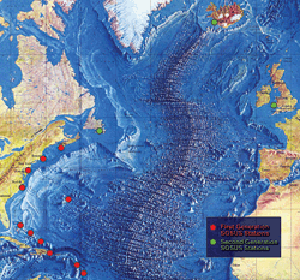
Sound Surveillance System (SOSUS) was the original name for a submarine detection system based on passive sonar developed by the United States Navy to track Soviet submarines. The system's true nature was classified with the name and acronym SOSUS classified as well. The unclassified name Project Caesar was used to cover the installation of the system and a cover story developed regarding the shore stations, identified only as a Naval Facility (NAVFAC), being for oceanographic research. The name changed to Integrated Undersea Surveillance System (IUSS) in 1985, as the fixed bottom arrays were supplemented by the mobile Surveillance Towed Array Sensor System (SURTASS) and other new systems. The commands and personnel were covered by the "oceanographic" term until 1991 when the mission was declassified. As a result, the commands, Oceanographic System Atlantic and Oceanographic System Pacific became Undersea Surveillance Atlantic and Undersea Surveillance Pacific, and personnel were able to wear insignia reflecting the mission.

USNS Kingsport (T-AG-164) was built as SS Kingsport Victory, a United States Maritime Commission VC2-S-AP3 (Victory) type cargo ship. During the closing days of World War II the ship was operated by the American Hawaiian Steamship Company under an agreement with the War Shipping Administration. After a period of layup the ship was operated as USAT Kingsport Victory by the Army under bareboat charter effective 8 July 1948. When Army transports were transferred to the Navy's Military Sea Transportation Service the ship continued as USNS Kingsport Victory (T-AK-239), a cargo transport. On 14 November 1961, after conversion into the first satellite communication ship, the ship was renamed Kingsport, reclassified as a general auxiliary, and operated as USNS Kingsport (T-AG-164).

A cable layer or cable ship is a deep-sea vessel designed and used to lay underwater cables for telecommunications, for electric power transmission, military, or other purposes. Cable ships are distinguished by large cable sheaves for guiding cable over bow or stern or both. Bow sheaves, some very large, were characteristic of all cable ships in the past, but newer ships are tending toward having stern sheaves only, as seen in the photo of CS Cable Innovator at the Port of Astoria on this page. The names of cable ships are often preceded by "C.S." as in CS Long Lines.

USNS Mizar (MA-48/T-AGOR-11/T-AK-272) was a vessel of the United States Navy. She was named after the star Mizar.
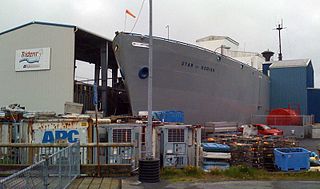
SS Albert M. Boe was a Liberty ship laid down on 11 July 1945 at the East Yard of New England Shipbuilding Corporation in Portland, Maine, as a boxed aircraft transport. The ship is notable as the final liberty ship built.
Albert Meyer may refer to:

USS Thor was a cable repair ship that supported Project Caesar, the unclassified name for installation of the Sound Surveillance System (SOSUS). Originally the Artemis-class attack cargo ship Vanadis (AKA-49) which was briefly in commission from 9 July 1945 to 27 March 1946, it was converted in 1955 after nine years in the reserve fleet.
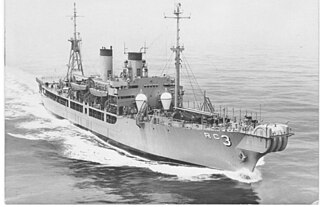
USS Turandot (AKA-47) was an Artemis-class attack cargo ship named after the minor planet 530 Turandot, discovered by Max Wolf in 1904 and named by him after the title character in the Puccini opera of the same name.

USCGC Yamacraw (WARC-333) was a United States Coast Guard Cable Repair Ship. The ship was built for the Army Mine Planter Service as U. S. Army Mine Planter Maj. Gen. Arthur Murray (MP-9) delivered December 1942. On 2 January 1945 the ship was acquired by the Navy, converted to an Auxiliary Minelayer and commissioned USS Trapper (ACM-9) on 15 March 1945. Trapper was headed to the Pacific when Japan surrendered. After work in Japanese waters the ship headed for San Francisco arriving there 2 May 1946 for transfer to the Coast Guard.

USNS Neptune (ARC-2), was the lead ship in her class of cable repair ships in U.S. Naval service. The ship was built by Pusey & Jones Corp. of Wilmington, Delaware, Hull Number 1108, as the USACS William H. G. Bullard named for Rear Adm. William H. G. Bullard. She was the first of two Maritime Commission type S3-S2-BP1 ships built for the US Army Signal Corps near the end of World War II. The other ship was the Albert J. Myer, which later joined her sister ship in naval service as the USNS Albert J. Myer (T-ARC-6).

USS Aeolus (ARC-3) began service as USS Turandot (AKA-47), an Artemis-class attack cargo ship built by the Walsh-Kaiser Co., Inc. of Providence, Rhode Island. In 1954 she was converted into a cable repair ship to support Project Caesar, the unclassified name for installation of the Sound Surveillance System SOSUS. Aeolus was the first of two ships, the other being USS Thor (ARC-4), to be converted into cable ships. Aeolus performed cable duties for nearly thirty years, from 1955 to 1973 as a commissioned ship and from 1973 until 1985 as the civilian crewed USNS Aeolus (T-ARC-3) of the Military Sealift Command (MSC). The ship was retired in 1985 and sunk as an artificial reef in 1988.

David C. Shanks was a troop transport that served with the US Army during World War II as USAT David C. Shanks, and during the Korean War with the US Navy's Military Sea Transportation Service as the USNS David C. Shanks (T-AP-180).
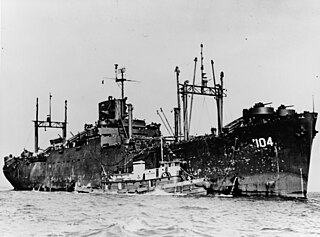
USS President Monroe (AP-104) was a President Jackson-class attack transport. that served with the US Navy during World War II. She was named after Founding Father and the fifth U.S. president, James Monroe.
The Alaska Communications System (ACS), also known as the Washington-Alaska Military Cable and Telegraph System (WAMCATS), was a system of cables and telegraph lines authorized by the U.S. Congress in 1900 and constructed by the U.S. Army Signal Corps. The communications lines were to serve both military and civilian needs in the territory of Alaska. By 1904, ACS comprised some 2,100 miles (3,400 km) of undersea cable, over 1,400 miles (2,300 km) of land lines, and a wireless segment across at least 107 miles (172 km). On May 15, 1936 WAMCATS was renamed the U.S. Army Alaska Communications System. The Alaska Communications System remained under the control of the Army Signal Corps until 1962 when it was taken over by the U.S. Air Force. The ACS handled the radioteletype, radio telephone, 500 kHz ship-to-shore frequencies, collected communications intelligence, and other services for more than half a century in Alaska.
USS Nashawena (AG-142/YAG-35) was a U.S. Navy cable layer constructed during World War II for the Army as the wooden-hulled self-propelled barge BSP 2008. The barge was completed converted to cable work for U.S. Army Signal Corps as the cable ship Col. William. A. Glassford supporting the Alaska Communications System in the shallow island waters of Alaska. She was transferred to the U.S. Navy in 1947 as a miscellaneous auxiliary and assigned to cable-laying duties for the U.S. Pacific Fleet.
USNS Flyer (T-AG-178), was a type C2-S-B1 cargo ship of the United States Navy, built for the Maritime Commission (MC) as Water Witch in service under charter by the commission to several lines until purchased in 1946 by United States Lines and renamed American Flyer. After being placed in the Reserve Fleet 14 December 1964 the title was transferred to the Navy for use as a deep ocean bathymetric survey ship supporting installation of the Sound Surveillance System (SOSUS). The Navy placed the ship in service 9 February 1965 with the name Flyer given on 22 March. The ship operated in that role until 1975.
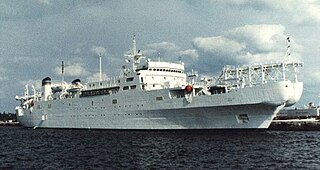
USNS Zeus (T-ARC-7) is the first cable ship specifically built for the United States Navy. Though planned to be the first of two ships of her class, the second ship was not built, leaving Zeus as the only ship of her class. She is capable of laying 1,000 miles (1,600 km) of cable at depths of up to 9,000 feet (2,700 m).
HMTS Monarch, launched on 8 August 1945 and completed during February 1946, was the fourth cable ship with that name. The ship was built for the General Post Office (GPO) for the laying and repair of submarine communications cable and was the largest cable ship in the world when completed and the first cable ship to have all electric cable machinery.














